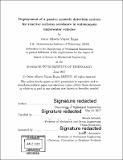Deployment of a passive acoustic detection system for reactive collision avoidance in autonomous underwater vehicles
Author(s)
Viquez Rojas, Oscar Alberto
DownloadFull printable version (10.59Mb)
Other Contributors
Massachusetts Institute of Technology. Department of Mechanical Engineering.
Advisor
Henrik Schmidt.
Terms of use
Metadata
Show full item recordAbstract
The use of autonomous vehicles in air, land and water has grown in recent years, with increased attention given to heavily transited areas. For the case of autonomous underwater vehicles, these regions of interest include harbors and river basins where the risk of collision rapidly increases with the number of ships. This thesis presents a collision avoidance system based on passive acoustic sensing, which may be used to alert an AUV's autonomy software of the threat that an approaching vessel may represent in such shallow water environments. Experiments were conducted to collect and process data from static and vehicle-mounted hydrophone arrays, and preliminary measurements were post-processed using various signal smoothing and data-fitting techniques. Results were then compared with a mathematical model used to describe the expected sound propagation profile, to identify how the system was limited by disturbances in the test conditions, such as variable ship speed and bearing, with respect to the vehicle's frame of reference. The benefits and limitations of each data processing approach were identified, and are herein discussed through three separate case studies to highlight the benefit of parallel-model fitting. A Bluefin SandShark AUV was used for a series of deployments performed to test the vehicle's ability to change behaviors in response to approaching vessels that present a chance of collision, relying exclusively on this passive sensing system as the alarm trigger. During the final autonomous behavior-response experiments spanning six distinct deployments, a total of 21 successful alarm triggers were recorded in the vehicle logs, along with a cumulative 142 minutes of acoustic data.
Description
Thesis: S.M., Massachusetts Institute of Technology, Department of Mechanical Engineering, 2017. Cataloged from PDF version of thesis. Includes bibliographical references (pages 75-76).
Date issued
2017Department
Massachusetts Institute of Technology. Department of Mechanical EngineeringPublisher
Massachusetts Institute of Technology
Keywords
Mechanical Engineering.